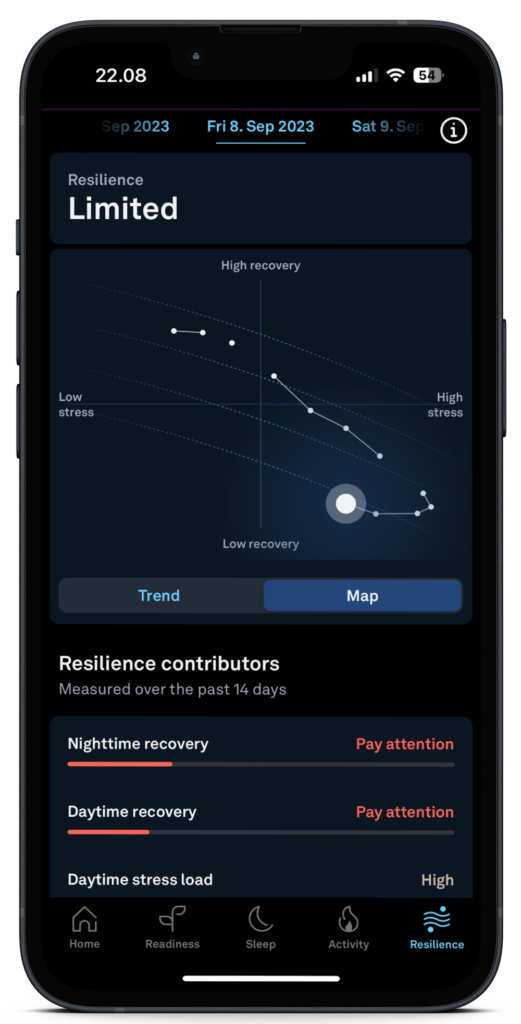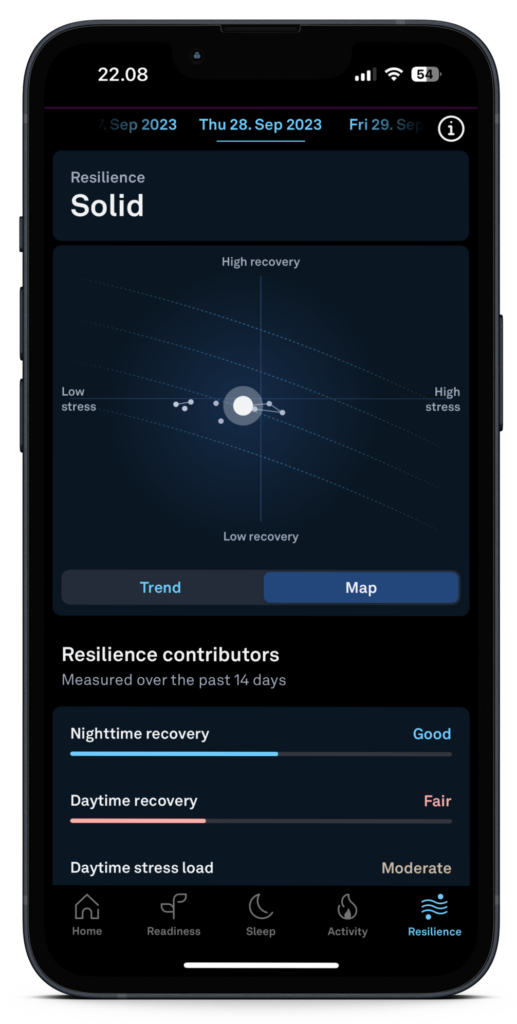Who: Nima S., 32, Helsinki, Finland
Surprising Oura insight: When his Resilience level lowered after an illness, Nima was surprised to see it rebound quickly once he started incorporating more intentional recovery strategies.
As a member of Oura’s science team, Nima used the new Resilience feature as part of an internal testing program to learn about his body’s resilience to physiological stress in the long term. “The feature has been extremely useful in helping me monitor how I recover from challenges,” he says. “I’ve been able to witness the intelligent adaptability of the body through the lens of physiology.”
At Oura, he’s one of the many scientists who contribute to the algorithms operating behind the scenes in the Oura App. “Delving into the core of the algorithms that produce the insights and metrics presented to our members is truly one of the most rewarding aspects of my work,” he says.
Here’s what he learned about his body’s adaptability to stress since testing the feature.
READ MORE: Building Resilience: Improve Your Ability to Recover From Stress
1. Using Daytime Stress helps me identify stress triggers, while Resilience gives me long-term context.
Since the Daytime Stress feature was introduced, I’ve become fascinated with linking the habits of my daily life to the data points on the graph. For example, I saw that exercise caused a spike in my physiological stress levels. Now using Resilience, I can see this in context: it improved my resilience in the long run.
When I look at my Resilience and its specific contributors, I correlate it with my life experiences from the past two weeks. For instance, if I see that my Daytime Recovery contributor metric is low, I know that I might have overdone it during the day (perhaps from exercising too regularly) and should take more breaks.
Observing this dynamic interplay between stress and recovery has helped me make more informed choices to support my body to become stronger and more resilient in the face of stress.
READ MORE: Burnout to Brilliance: How to Make the Most of Your Work Breaks
2. I’ve learned that adequate recovery methods empower me to rebound quickly from stress.
This feature enables me to observe the balance between my overall stress and recovery. I have become particularly fascinated by how my body copes and rebounds when confronted with challenges, whether it’s a new diet, an exercise routine, or recovering from an illness.
Recently, I was sick for a week. The change in my Resilience was particularly interesting. It was like a boomerang: I went from a “Strong” Resilience level all the way down to “Limited,” then bounced back to “Solid” once I started prioritizing recovery. My recovery consisted of lots of sleep for a few consecutive days, minimal exercise, vitamin C supplements, and lots of rest.
I’ve realized that recovery isn’t the result of just one action; it’s the result of many habits over time. One habit that helped improve my resilience is increasing my restorative time. During the day, this might look like reading a book or taking a break from work; at night, it means going to bed on time and practicing good sleep hygiene.
3. I can improve my long-term Resilience level, despite dips in my daily Readiness Score.
Recently, I joined a gym and began strength training. Exercise acts as a strange new stressor to my body, so it has been interesting seeing this spike on the Daytime Stress graph and seeing changes in my sleep and readiness in the days following, as a result. Specifically, I look at changes in my resting heart rate and heart rate variability (HRV) because strength training elevates the metabolism for as long as a few days, so these metrics are the most likely to be affected.
I have noticed that despite the impact on my resting heart rate, HRV, Sleep, and Readiness Score after a tough training session, exercising more regularly actually improves my Resilience over time. So while exercise is a source of stress, it’s clearly a positive stress that contributes to better stress resilience.
READ MORE: The Difference Between “Bad” and “Good” Stress
4. A great night’s sleep supports my Daytime Recovery.
While I’m not great at committing to a routine like meditation, I do make an effort to sleep well. For instance, I always try to maintain a regular sleep schedule and ensure I get enough sleep. Interestingly, since using Resilience, I’ve learned that having a good sleeping routine really bolsters my ability to recover during the day.
RELATED: Rest & Resilience: The Role of Sleep in Stress Management
What’s Your Oura Story?
Everyone’s story is unique, and we’d love to hear yours. Share your story here.












